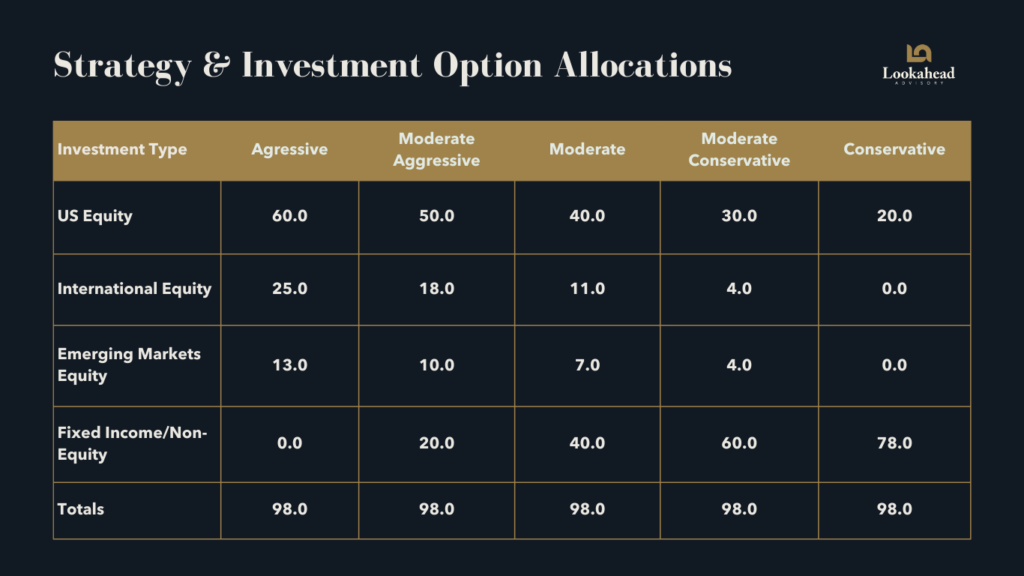One size does not fit all when investing.
Every investor is unique, with nuanced goals, concerns, and ideas of when they’d like to start tapping into their investments.
Their portfolios need to reflect that.
You can’t just copy and paste other portfolios or select assets on a whim. It takes a structured approach to identify and select the right assets that balance risk and return.
At Lookahead Advisory, we call this the ‘building-blocks’ approach. Here’s how we use it to help our clients build customized investment portfolios that fit their needs.
Key Takeaways:
✅ No single portfolio fits all—customization is essential.
✅ Risk tolerance and time horizon dictate asset allocation.
✅ Ongoing monitoring and rebalancing optimize performance.
What is the building blocks approach to investing?
The building block approach uses an investor’s unique risk tolerance, financial goals, and time horizon to assemble a personalized combination of asset classes, including equities, fixed income, and cash equivalents.
This strategy helps balance risk and return through diversification and periodic adjustments, ensuring longevity and stability in performance.
1. Understand your risk tolerance
Successful investing starts with knowing your risk tolerance—your ability and willingness to endure market fluctuations in pursuit of potential gains.
Unsure what level of risk you’re comfortable with? See which of these five common risk profiles best reflects you:
Aggressive portfolio (High growth + High risk)
Ideal for young investors, these portfolios are primarily equity-focused to maximize growth potential. With a long-term horizon, the portfolios are designed to tolerate more short-term market volatility.
- Heavy allocation to equities, including small-cap stocks, emerging markets, and technology.
Growth portfolio (Moderately high risk)
These investors are typically in their 30s or 40s and remain in growth and accumulation phases. The objective here is to balance equities with a slightly reduced risk exposure.
- Still equity-focused but includes some fixed income for stability.
Balanced Portfolio (Moderate risk)
Targeting investors nearing the end of their investment cycle, the focus here shifts towards defensive strategies. A 60/40 equity-to-fixed income ratio is typical, ensuring diversification and safeguards against market downturns.
- A mix of stocks, bonds, and alternative assets for diversification.
Conservative Growth Portfolio (Moderately low risk)
Common among retirees drawing income, these portfolios incorporate a mix of equities and a heavier fixed income allocation for greater stability.
- More fixed income exposure, with some equity for controlled growth.
Capital Preservation Portfolio (Low risk + Stability focused)
For retirees in their 80s and above, portfolios prioritize minimal risk, focusing on capital longevity with a larger proportion of fixed income versus equities.
- Heavy allocation to bonds and cash, with minimal stock exposure.
It’s natural to see these options and still not know your appetite for risk. Remember, if you choose one, you’re not locked in. The need and desire for risk will likely change over time, and you’ll move up or down this scale.
You just need to find a starting point that you’re comfortable with. If you’re still unsure, connect with a professional advisor for additional guidance.
2. Establish your investor profile
Risk tolerance provides an outline of what your investment portfolio should look like. Your goals, time horizon, age, and account preferences provide more detailed instructions for how your portfolio should be structured.
This personal profile becomes the lens through which we determine the appropriate level of risk. It’s not just about what markets are doing—it’s about aligning the portfolio’s design with what the investor needs it to do, how long they have to achieve those goals, and how comfortable they are along the way.
In some cases, this requires an evaluation of existing portfolios.
- Are there positions worth keeping?
- Do they have strong preferences—such as a tilt toward gold, digital assets, or sustainable investing?
Understanding these choices helps identify both behavioral and strategic tendencies that may influence your current investment strategy.
For example, you have two investors. Both are interested in seeing higher returns and are willing to take more risks. However, one is a younger investor saving for retirement in 30 years, the other is nearing retirement.
While both of these investors technically fall under the “growth portfolio” risk tier, their profiles look nothing alike.
The more seasoned investor needs to account for their short-term retirement goal, plan for drawing income, and consider protecting existing investments. The younger investor simply lacks these concerns.
3. Stack the “building blocks” of your portfolio
You now have the complete instruction manual that defines you as an investor. With that in mind, we can look at our ‘blocks’ (asset types) and construct your final investment portfolio.
Core Asset Classes (The Foundation)
These core asset classes—equities, fixed income, and cash—form the foundation of your portfolio. Each serves a specific purpose: growth, stability, or liquidity.
- Equities (Stocks): Provide growth potential but come with higher volatility. Includes large-cap, mid-cap, small-cap, and international stocks.
- Fixed Income (Bonds): Offer stability and income. Includes government bonds, corporate bonds, and high-yield bonds.
- Cash & Cash Equivalents: Provides liquidity and capital preservation but with minimal returns.
Diversification Elements (The Enhancements)
These assets often have a low correlation with your traditional (core) asset classes, meaning they can perform differently under the same market conditions. This diversification helps reduce overall portfolio risk and volatility.
- Alternative Investments: Real estate (REITs), commodities (gold, oil), private equity, and hedge funds.
- Geographic Diversification: Domestic vs. international investing, developed vs. emerging markets.
Risk Management Tools (The Safety Net)
Your portfolio should always be “under construction.” Proactive measures can reduce or offset the risk of prices moving against you, while revisiting the ‘blocks’ you’re using ensures the portfolio still meets your needs.
- Hedging with Derivatives: Options and futures to manage risk.
- Rebalancing Strategies: Adjusting allocations to maintain the intended risk level.
Finalized investment portfolio example
Once the building blocks are identified, financial planners allocate them based on risk tolerance and investment goals.
Here’s a general breakdown of how different portfolios are typically structured:

Don’t be hands-off—stay on track with regular portfolio reviews
An effective portfolio isn’t set-it-and-forget-it—it requires ongoing attention.
Over time, growth in different asset classes can cause your allocation to drift, potentially exposing you to unintended risk. Regular rebalancing brings your portfolio back in line with your long-term strategy, while tactical adjustments allow us to respond to changing market conditions.
Risk management tools—like hedging and tax-efficient asset placement—add layers of protection and help maximize after-tax returns. Combined with strategic and tactical allocation, these tools ensure your portfolio remains aligned with your goals, even as markets shift.
Our building-block approach simplifies portfolio construction by focusing on the core components of investing—growth, income, liquidity, diversification, and protection. This framework allows us to tailor each portfolio to the individual, creating resilient strategies for every stage of life and market cycle.
Are you confident in your current investment strategy?
Whether you’re planning for retirement, growing a business, or just getting started, we’re here to help you build a portfolio that works for you.
Connect with our experienced financial advisors to explore your options, clarify your goals, and build a strategy designed for long-term success.


